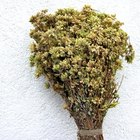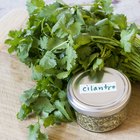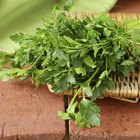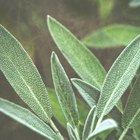
The Mediterranean herb sage has a slightly minty taste and aroma. It's recommended for primarily poultry recipes, yet it pairs well in other dishes, too. Drying fresh sage leaves can provide you with a steady supply of herbs all throughout the winter. Be aware that the herb's flavor and scent becomes stronger when dried; use it sparingly. Whole sage leaves retain their flavor better than those that are crushed or ground; wait until you are ready to use them to crush them.
Harvest sage leaves still on the stem, preferably.
Wash the sage leaves under cool running water to remove any dirt or other debris.
Place the leaves in a colander to dry.
Dry any remaining moisture from the leaves with a paper towel.
Bunch the sage stems together and place the leaves and stems into a brown paper bag.
Close the bag around the stems and tie the bag shut with a piece of twine or string.
Poke several holes in the bag with the tip of a sharp knife or a pair of scissors to provide ventilation.
Hang the bag by its string from a nail or another place it can remain suspended. Choose a room that is warm, dark and airy, such as an attic or closet.
Allow the sage leaves to dry for about two weeks. Check the bag occasionally for signs of mold growth. Throw away the bag if you discover mold growth.
Snap the leaves from the stems when they are completely dried; throw away the stems. Dried sage leaves should look and feel completely crisp, with no soft spots.
Related Articles

How to Dry or Freeze Oregano

How to Dry Cilantro at Home

How to Make Rubbed Sage

How to Care for a Nylon Handbag
How to Keep Mint Fresh for Drink ...

How to Substitute Dried for Fresh Dill ...

The Difference in Fresh or Dry Oregano

How to Dry Papaya Leaf for Tea

How to Care for Napa Leather

How to Freeze Fresh Parsley

How to Dry Sage

Perfect Way to Cook a Pork Chop in the ...

What Color of a Handbag Goes Best With ...

How to Care for Berets

How to Freeze Tzatziki

How to Get Mold Out of Leather Purses

How to BBQ a Rabbit

How to Store Leather Shoes

How to Identify Vintage Purses

How to Store Suede Clothes
References
Tips
- Store dried sage leaves in an airtight container away from light for up to 6 months. Suggested containers include resealable bags, lidded plastic containers or vacuum bags.
- Select sage leaves with no wilting, soft spots or edges that appear dry.
- You can also lay sage leaves on screens to dry.
- Use sage leaves in dishes with any meat, pork, poultry or fish. They also pair well with eggplant, peas, tomatoes, apples, cheese and beans.
Writer Bio
Sommer Leigh has produced home, garden, family and health content since 1997 for such nationally known publications as "Better Homes and Gardens," "Ladies' Home Journal," "Midwest Living," "Healthy Kids" and "American Baby." Leigh also owns a Web-consulting business and writes for several Internet publications. She has a Bachelor of Science in information technology and Web management from the University of Phoenix.
Photo Credits
Medioimages/Photodisc/Photodisc/Getty Images